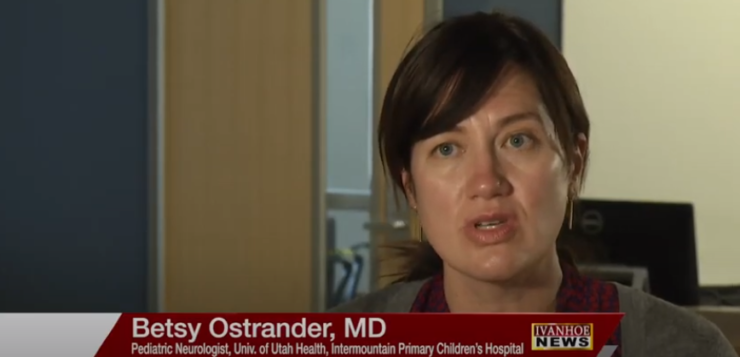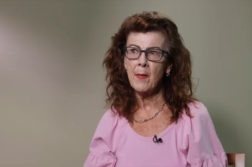Betsy Ostrander, MD, Pediatric Neurologist at the University of Utah, Assistant Professor with specialty in Neonatal Neurology, talks about a new way to diagnose cerebral palsy earlier than ever before.
Can you explain, what is cerebral palsy?
OSTRANDER: Cerebral palsy is a disorder of tone and function. It’s the result of an injury typically to the developing brain. We see it most often in babies who have injury related to the birth process. So, sometimes birth asphyxia. It’s also common in babies who are born very early. The brain is very fragile and is prone to injury. If that injury causes problems with muscle tone, that limits their ability to function and makes it hard to do things like sit and roll and walk. That is what we call cerebral palsy.
How common is cerebral palsy?
OSTRANDER: It’s really quite common across the world. It’s one of the most common neurological disorders of children and one of the top causes of physical disability. CP occurs in about 1 in every 320 children.
Do you automatically know when a child has cerebral palsy, or when are they usually diagnosed?
OSTRANDER: Though the injury can happen around the time of birth, we often don’t know until months or years later. So, prior to this project that we’ve been working on, the average age of diagnosis was between two and three years, sometimes as late as four years of age. This puts families in a stressful position because many of them know something is wrong, but they aren’t really sure what is wrong or how to deal with it. It can take months or years to see the full impact of the brain injury but there are signs much earlier that there are problems because it needs to be long enough that you can see the effects of that brain injury and the effects on the body.
What signs would the baby be showing at age two or three years?
OSTRANDER: Oftentimes, one of the first signs we see is that babies don’t use their hands well or maybe their muscles start to get tight. They often have a delay in their motor skills, so they may be slower to achieve milestones like rolling or sitting or walking. And they may not be able to reach and grasp well.
Why is it important to get an early diagnosis?
OSTRANDER: Diagnosing kids early can decrease the stress that parents feel. We can really start to focus on what the solutions are and how we can most help these children reach their neurodevelopmental potential. If we’re not diagnosing kids until three or four years old, we’re losing the ability to harness the brain’s natural plasticity to work around those areas of injury and develop new pathways that can help them do things like sit and roll and walk. So, diagnosing early allows us to harness the brain’s natural plasticity to make that happen.
How are you now able to diagnose it just days or weeks after birth?
OSTRANDER: When we first started this project in 2018, our average age of diagnosis was right around two years of age. Then, in a collaboration with the Cerebral Palsy Foundation and Nationwide Children’s Hospital in Columbus, Ohio, we were able to implement some recommendations and use tools that look at the very first movements we see in babies and how those movements might be abnormal in kids who are going to go on to develop cerebral palsy. We standardized these tools and started evaluating kids right at the time of their due date. We could start to see some red flags, and then we would bring them back at three months or six months. We brought our age of diagnosis down to about 11 months of age. In some of our most severely affected kids, we might be able to diagnose them at four or five or six months of age. At that point, we can really focus with parents on how we maximize the child’s function and step away from this waiting game.
What are some of the specific movements you look for?
OSTRANDER: We use a tool called the Prechtl General Movement Assessment. The general movements are the kind of typical baby movements that we don’t really notice when we look at a baby, but they’re kind of writhing and twisting. In kids who go on to have cerebral palsy, those movements aren’t present. Their movements tend to be very stiff and contracted, and the babies seem almost uncomfortable, like they’re grunting during some of the movements. That is a very important sign for us to kind of clue in that something’s not developing quite right. We repeat that assessment a few months later and look for other movements, kind of small movements that babies should be developing in their hands and their feet. If those are not present, that has a very high sensitivity and specificity for going on to develop neuromotor problems like cerebral palsy.
What would be some of those signs be, specifically?
OSTRANDER: The way we assess it is by recording a baby’s movements for two minutes. Then, we watch the video because it’s so hard when you’re looking at a baby to appreciate these very fine movements. At three months of age, we’re looking for movements that are called fidgets. These are very little multidirectional movements that babies may have at the hands or the feet or the shoulders. Once you’ve seen this a few times, you pick it up right away. These are normal baby movements that we kind of take for granted. But when they’re not there, it’s a signal of a big problem.
Does that progress over months or a year, or are there different things that you look for then?
OSTRANDER: Absolutely. That movement assessment we only do up until three months of age, but we continue to assess the babies with standardized neurological exams and functional assessments. All of those tools are pieces of the puzzle and help us to be confident once we also have imaging and a history that go along with it to be able to make that diagnosis of cerebral palsy.
How will you change these kids’ lives by diagnosing them earlier?
OSTRANDER: What our hope is and what we’ve been working with families to do is as soon as we make this diagnosis, we shift the focus on if the child has cerebral palsy to how can we best help your child with cerebral palsy? There are some promising interventions like things we can do in the upper extremities to improve function, or things you can do to assist their weight bearing that can help them with ambulation. And we really focus on what interventions are going to be most effective early to help these kids maximize their development.
Could it be a difference between a child being able to walk and not walk?
OSTRANDER: That’s a little hard to say because right now we’re still in the earliest part. What we’re hoping is that the sooner we can diagnose it, the sooner we can intervene. As we continue to follow and research these issues, we can evaluate that exact question. Are we helping kids to be more functional? We do know that early intervention programs across the country, effective therapies, engaged parents and enriching home environments, are so important to a child’s development. That whole combination of things can make a difference between children walking and children not walking. So, I think early diagnosis is just going to be part of one of the many things that, together, can help maximize these kids’ future.
Where does your research go next?
OSTRANDER: We have the first three years of this project with the Cerebral Palsy Foundation, which has been focusing on just implementing this infrastructure. How do we identify the highest risk kids and then make that diagnosis early, when appropriate? The next three years is looking at what interventions are going to be most effective in this group of kids to help them do their best?
Interview conducted by Ivanhoe Broadcast News.
END OF INTERVIEW
This information is intended for additional research purposes only. It is not to be used as a prescription or advice from Ivanhoe Broadcast News, Inc. or any medical professional interviewed. Ivanhoe Broadcast News, Inc. assumes no responsibility for the depth or accuracy of physician statements. Procedures or medicines apply to different people and medical factors; always consult your physician on medical matters.
If you would like more information, please contact:
Julie Kiefer
801-597-4258
Sign up for a free weekly e-mail on Medical Breakthroughs called First to Know by clicking here




